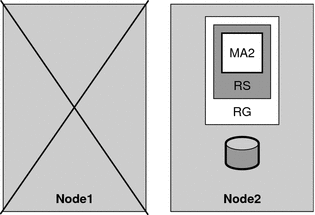Highly Available HADB Management Agent
The Management Agent component of Sun Java System Application Server EE (HADB) is made highly available by creating a data service resource in a resource group that is configured to be mastered by multiple nodes at the same time. In this resource group, the maximum number of primary nodes and the desired number of primary nodes must be the same. This configuration is described in detail in Registering and Configuring the Sun Cluster HA for Sun Java System Application Server EE (HADB).
The following figure illustrates a two-node configuration before any failure occurs on a node.
Figure 1–2 Management Agents Mastered on Multiple Nodes—Before Failure

The figure illustrates two management agents, indicated by MA1 and MA2, on different cluster nodes. The application is installed on the local file system on each node. With the Sun Cluster HA for Sun Java System Application Server EE (HADB) data service, the two management agents are configured in one resource, indicated by RS, and this resource is configured in one resource group, RG. The resource group is configured to be mastered on multiple cluster nodes at one time, in this case, Node1 and Node2.
The data service manages starting the management agents on all the nodes on which they are configured. The management agents in turn start the Node Supervisor (NSUP) process, which then starts the HADB node processes. If a management agent fails, the data service restarts it, based on user-defined parameters. If the HADB node processes fail, the management agent restarts them. If any databases have stopped, the user must restart these databases by issuing commands on the command line.
If the user-defined parameters determine that the data service does not restart the management agent after a failure, the processes remain down on that node. However, the management agent processes on the other managed nodes continue to execute. No failover occurs.
The following figure illustrates the two-node configuration after the failure of the first node. All the processes on the first node are down, and the second node continues to execute its processes.
Figure 1–3 Management Agents Mastered on Multiple Nodes—After Failure

- © 2010, Oracle Corporation and/or its affiliates
